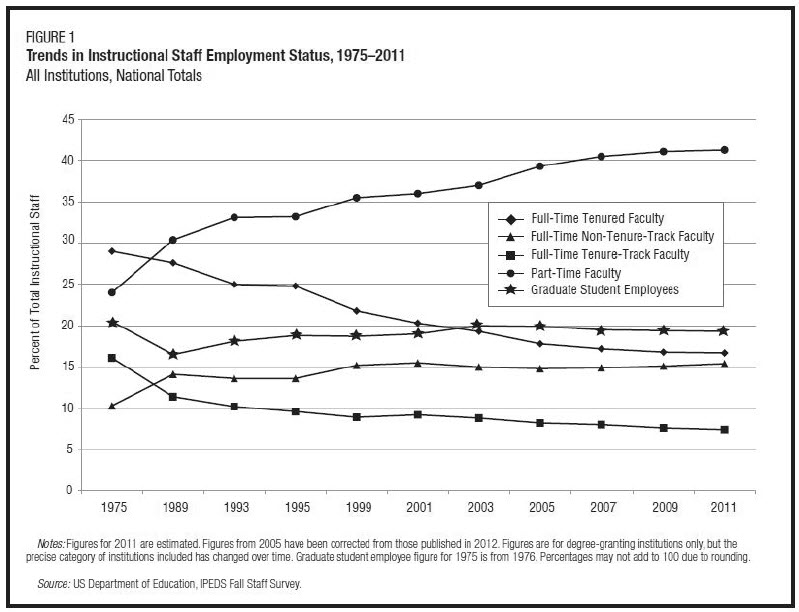Regarding the operation of a club, a firm, or a governmental office, I sometimes hear the statement, “It should be run like a business.” Sounds good. But does “running like a business” apply to government? Especially to schools?
Recent research reports (Kezar, TIAA-CREF), a congressional report, a science news journal, and even a sharp-toothed newsletter expose a disturbing trend in college-level education. The schools are using “contingent” faculty to teach a large fraction of the courses. That’s like using substitute engineers and metalworkers to design and assemble your airplane. It sure saves money, and it might work. For a while. Along with other forms of cost-cutting by quality-cutting and wage-cutting, there will ultimately be a price paid by the entire society. Such corporate-style schools cheat the teachers, and ultimately the students.
Colleges reduce costs by using various types of contingent faculty, with titles such as “adjunct” or “lecturer.” These teachers are part-time, usually hired temporarily to teach a specified course, without benefits or assurance of continuing employment beyond the quarter or semester. A few of these teachers are successful professionals in the world beyond the college, experts who bring their experience to the students. However, most of the adjunct faculty have advanced academic degrees, they are employed one course at a time with much lower compensation than regular faculty. Some work by commuting between two or three different schools in order to survive. And most of the adjuncts do it because they love teaching and love students, despite being denied the salary, the time, and office space for the one-on-one interactions that assist students.
Across America, an adjunct’s median pay for a three-credit course is $2,000-$3,000. If an adjunct taught three such courses for four quarters (a full year), he/she might make $30,000—that is, if he/she could keep up the schedule and be re-hired each term for several courses. Some state legislators, unfamiliar with education, think teaching only nine hours per week is equivalent to a paid vacation that leaves four days per week for golf. What those legislators don’t understand is the amount of work done outside the lecture. Teaching three 3-credit courses is a load.
When I was teaching, I put in about 5 hours preparation for each class hour—in addition to grading papers, faculty meetings, and individual counseling with students. For a 9-hour schedule, that would make a 60-hour week. Perhaps you could teach 12 hours in a 60-hour week if two or three of the classes were different sections of the same course. For the adjunct, the work is done not knowing how many hours, if any, he/she will be assigned during the next term. Of course, the school counts only the in-class contact hours. That might keep the worker under the limits required for medical coverage or other benefits, another saving of expense.
 What’s going on? The graph from the congressional report shows that the fraction of full-time faculty (tenured or tenure-track) has decreased during the last thirty years, while the fraction of part-time faculty rose from about 24% in 1975 to 41% in 2011. It might seem good that colleges are saving money. But if saving is so important, why are college presidents now receiving multiple-hundred-thousand dollar salaries? In a later post, we’ll look at another way colleges generate income by taxing the professors’ research. These concerns raise a question: should it be the objective of a college to profit and grow? To garner prestige?
What’s going on? The graph from the congressional report shows that the fraction of full-time faculty (tenured or tenure-track) has decreased during the last thirty years, while the fraction of part-time faculty rose from about 24% in 1975 to 41% in 2011. It might seem good that colleges are saving money. But if saving is so important, why are college presidents now receiving multiple-hundred-thousand dollar salaries? In a later post, we’ll look at another way colleges generate income by taxing the professors’ research. These concerns raise a question: should it be the objective of a college to profit and grow? To garner prestige?
So what can a person do?
If you are contemplating going to college, or even taking a course, study all of the school’s catalogs and publications. What fraction of courses, especially basic courses, are taught by adjuncts? Does the school even list it’s adjunct faculty or acknowledge the teaching done by hourly staff, or do they advertise only leading professors? Make an appointment to talk to the chair of a department in which you are interested. Ask that professor which courses are taught by adjuncts. Ask where the offices of the adjuncts are. Ask what the adjuncts are paid. That’s not being nosy. It indicates you are a serious student. If the chair is offended by polite questions, that’s a signal that the school, or at least that department, may not share your priorities.
If a state-supported school makes money (reduces its demand on the legislature), and/or if it is expanding, it is regarded as successful despite the fact that tuition is up and salaries are down. College has become a business, but where’s the money going? Paying a pittance to dedicated teachers is one way to reduce cost while supporting an inflated overhead. It’s time to ask questions. Even embarrassing questions. Do corporate schools make good educational tools?